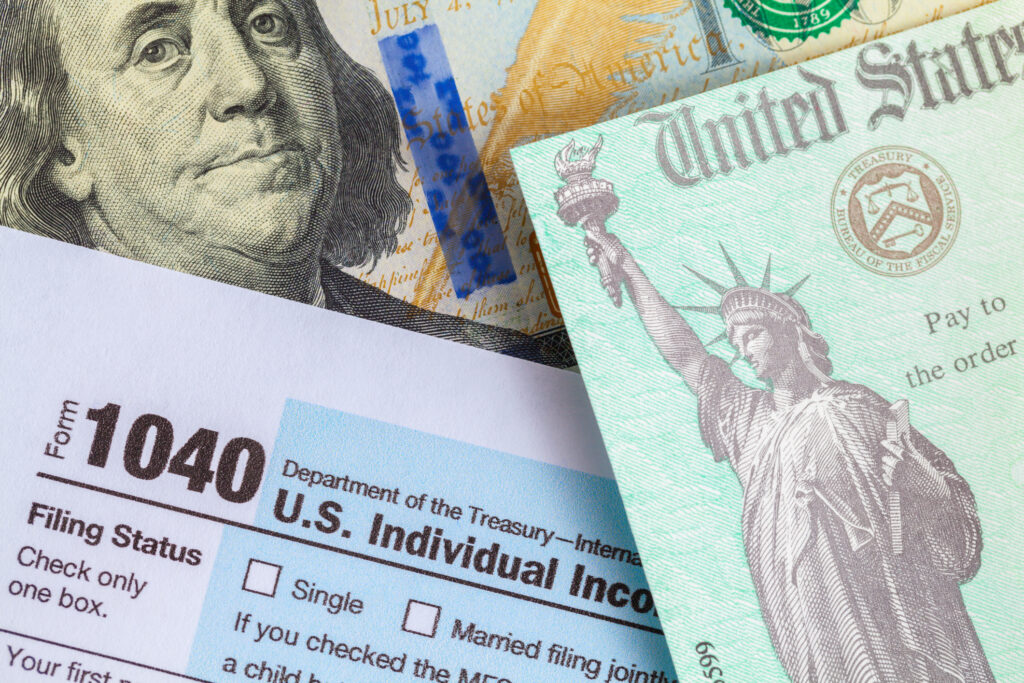
Key tax changes and opportunities for families, executives, and entrepreneurs
On July 4, 2025, H.R. 1 referred to below as “the Act” (formerly the One Big Beautiful Bill Act – OBBBA) was signed into law by President Donald Trump. The Act extends many of the expiring provisions from the Tax Cuts and Jobs Act (TCJA) and includes other Trump administration tax priorities.
From permanent adjustments to tax rates to expanded deductions and credits, lawmakers are reshaping the financial terrain for individuals with substantial assets. Here’s a breakdown of what you need to know—and where new opportunities may arise.
Tax rates: The Act generally makes the tax rates enacted in 2017 in the TCJA permanent. The Act adds an additional year of inflation adjustment for determining the dollar amounts at which any rate bracket higher than 12% ends and at which any rate bracket higher than 22% begins.
Standard deduction: The Act makes the TCJA’s increased standard deduction amounts permanent. The following are the standard deduction increases for tax years beginning after 2024:
- $15,750 for single filers
- $23,625 for heads of household
- $31,500 for married individuals filing jointly
The standard deduction will be adjusted for inflation after that. These changes have been made retroactive to include 2025.
State and Local Tax (SALT) cap: The H.R. 1 temporarily increases the limit on the federal deduction for the SALT cap to $40,000 (from the current $10,000) and adjusts it for inflation. In 2026, the cap will be $40,400, and then will increase by 1% annually, through 2029. Starting in 2030, it will revert to the current $10,000.
The deduction phases down for taxpayers with modified adjusted gross income (MAGI) over $500,000 (in 2025). The MAGI threshold will be adjusted for inflation through 2029. The phasedown will reduce the taxpayer’s SALT deduction by 30% of the amount the taxpayer’s MAGI exceeded the threshold, but the limit on a taxpayer’s SALT deduction could never go below $10,000.
Personal exemptions and senior deduction: The Act permanently sets the deduction for personal exemptions at zero. However, it provides a temporary $6,000 deduction for individual taxpayers who are age 65 or older. This senior deduction begins to phase out when a taxpayer’s MAGI exceeds $75,000 ($150,000 in the case of a joint return). It will be in effect for the years 2025 through 2028.
Qualified Business Income (QBI) deduction: The Act makes the Sec. 199A QBI deduction permanent and keeps the deduction rate at 20%. The Act expands the Sec. 199A deduction limit phase-in range for a specified service trade or business (SSTBs) and other entities subject to the wage and investment limitation by increasing the $50,000 amount for non-joint returns to $75,000 and the $100,000 amount for joint returns to $150,000.
The Act also introduces an inflation-adjusted minimum deduction of $400 for taxpayers who have at least $1,000 of QBI from one or more active trades or businesses in which they materially participate.
Alternative minimum tax exemption (AMT): The Act permanently extends the TCJA’s increased AMT exemption amounts and reverts the exemption phaseout thresholds to their 2018 levels of $500,000 ($1 million in the case of a joint return), indexed for inflation. The Act increases the phaseout of the exemption amount from 25% to 50% of the amount by which the taxpayer’s alternative minimum taxable income exceeds the threshold amount.
Mortgage interest deduction: The Act permanently extends the TCJA’s provision limiting the Sec. 163 qualified residence interest deduction to the first $750,000 in home mortgage acquisition debt. It also makes permanent the exclusion of interest on home-equity indebtedness from the definition of qualified residence interest. The Act also treats certain mortgage insurance premiums on acquisition indebtedness as qualified residence interest.
Casualty loss deductions: Under the Act, the TCJA’s provision limiting the itemized deduction for personal casualty losses to losses resulting from federally declared disasters becomes permanent. H.R. 1 expands the provision to include certain state-declared disasters.
Miscellaneous itemized deductions: The Act makes permanent the TCJA’s suspension of the Sec. 67(g) deduction for miscellaneous itemized deductions but removes unreimbursed employee expenses for eligible educators from the list of miscellaneous itemized deductions.
Itemized deductions limitation: The Act permanently removes the Sec. 68 overall limitation on itemized deductions (known as the Pease limitation) and replaces it with a new overall limitation on the tax benefit of itemized deductions. The amount of itemized deductions otherwise allowable would be reduced by 2/37 of the lesser of (1) the amount of the itemized deductions or (2) the amount of the taxpayer’s taxable income that exceeds the start of the 37% tax rate bracket.
No tax on tips: The Act provides a temporary deduction of up to $25,000 for qualified tips received by an individual in an occupation that customarily and regularly receives tips. The deduction will be allowed for both employees receiving a Form W-2 and independent contractors who receive Form 1099-K, or Form 1099-NEC, or those that report tips on Form 4317. The deduction would be an above-the-line deduction and, therefore, available for taxpayers who claim the standard deduction or itemize deductions. The deduction begins to phase out when the taxpayer’s MAGI exceeds $150,000 ($300,000 in the case of a joint return). This temporary deduction will be available for tax years 2025 through 2028.
The Act also extends the Sec. 45B credit for a portion of employer Social Security taxes paid with respect to employee cash tips to certain beauty service businesses.
No tax on overtime: The Act provides a temporary above-the-line deduction of up to $12,500 ($25,000 in the case of a joint return) for qualified overtime compensation received by an individual during a given tax year. The deduction begins to phase out when the taxpayer’s MAGI exceeds $150,000 ($300,000 in the case of a joint return). Overtime deductions would only be allowed for qualified overtime compensation if the total amount of qualified overtime compensation is reported separately on Form W-2 (or Form 1099, if the worker is not an employee). This temporary deduction will be available for tax years 2025 through 2028.
Wagering losses: The Act amends Sec. 165(d) to clarify that the term “losses from wagering transactions” includes any deduction otherwise allowable under Chapter 1 of the Code incurred in carrying on any wagering transactions. The Act limits the term “losses from wagering transactions” to 90% of the amount of those losses, and losses will be deductible only to the extent of the taxpayer’s gains from wagering transactions during the tax year.
Charitable contributions and estate planning
Tax benefits for philanthropic individuals
Credit for contributions to scholarship-granting organizations: The Act enacts a new Sec. 25F that provides a credit of the greater of $5,000 or 10% of the taxpayer’s AGI for charitable contributions to scholarship-granting organizations. The credit comes with a $4 billion annual cap (starting in 2027), and the credit will be allocated on a first-come, first-served basis, up to that cap.
The provision also creates a Sec. 139K, which excludes from income scholarships for the qualified secondary or elementary education expenses of eligible students.
Charitable contribution deduction: The Act creates a charitable contribution deduction for taxpayers who do not elect to itemize, allowing nonitemizers to claim a deduction of up to $1,000 for single filers or $2,000 for married taxpayers filing jointly for certain charitable contributions. For itemizers, the Act imposes a 0.5% floor on the charitable contribution deduction: The amount of an individual’s charitable contributions for a tax year is reduced by 0.5% of the taxpayer’s contribution base for the tax year (where the base is defined as AGI calculated without taking into account any charitable giving).
Estate and gift tax exemption amounts: The Act amends Sec. 2010 to permanently increase the estate tax exemption and lifetime gift tax exemption amounts to $15 million for single filers ($30 million for married filing jointly) in 2026 and index the exemption amount for inflation after that.
Family provisions
Overview of tax credits and assistance for families
ABLE accounts: The Act makes various changes to Sec. 529A ABLE accounts, including making permanent the TJCA’s increased limitation on contributions to ABLE accounts. The Act also makes permanent the inclusion of ABLE account contributions as eligible Sec. 25B saver’s credit contributions, but after 2026 only ABLE account contributions will be eligible saver’s credit contributions. The credit amount increases from $2,000 to $2,100.
Adoption credit: The Act makes a portion (up to $5,000) of the Sec. 23 adoption credit refundable. That amount will be adjusted for inflation.
Child tax credit: The Act increases the amount of the nonrefundable child tax credit to $2,200 per child beginning in 2025 and indexes the credit amount for inflation. The Act also makes permanent the $1,400 refundable child tax credit, adjusted for inflation. In addition, it makes permanent the increased income phaseout threshold amounts of $200,000 ($400,000 in the case of a joint return), as well as the $500 nonrefundable credit for each dependent of the taxpayer other than a qualifying child.
Dependent care assistance programs: The maximum annual amount excludable from income under a Sec. 129 dependent care assistance program increases from $5,000 to $7,500 under H.R. 1.
Child and dependent care credit: The Act permanently increases the amount of the child and dependent care tax credit from 35% to 50% of qualifying expenses. The credit rate phases down for taxpayers with adjusted gross income (AGI) over $15,000. It will be reduced by 1 percentage point (but not below 35%) for each $2,000 that the taxpayer’s AGI exceeds $15,000. It will then be further reduced by (but not below 20%) 1 percentage point for each $2,000 ($4,000 for joint returns) that their AGI exceeds $75,000 ($150,000 for joint returns).
Sec. 529 plans: The Act allows tax-exempt distributions from Sec. 529 savings plans to be used for additional educational expenses in connection with enrollment or attendance at an elementary or secondary school. The Act also allows tax-exempt distributions from 529 savings plans to be used for additional qualified higher education expenses, including “qualified postsecondary credentialing expenses.”
New! – Trump accounts: The new Act creates a type of savings account for the benefit of individuals under age 18 called “Trump accounts”. These savings accounts are akin to traditional IRAs and would grow tax-deferred. Parents can elect (by checking a box on their tax return) to have the government fund $1,000 into the account for any children born from 2025-2028. In addition to this one-time contribution, parents can also make contributions of up to $5,000 in calendar years before the beneficiary turns 18 (contributions can be made for any child under 18, not just those born from 2025-2028). Distributions from Trump accounts can only be made starting in the calendar year the beneficiary turns 18. Trump accounts will have to be designated as such when they are set up, and the Act does not allow Trump account contributions until 12 months after the date of enactment of the Act.
Other provisions
Bicycle commuting reimbursements: The Act permanently excludes qualified bicycle commuting reimbursements from the list of qualified transportation fringe and other commuting benefits, making them taxable to employees.
Car loan interest: H.R. 1 provides a tax break for vehicle owners: an above-the-line deduction of up to $10,000 for qualified passenger vehicle loan interest each year for the years 2025-2028.
- The deduction phases out for those with a MAGI of over $100,000 ($200,000 for joint filers).
- Vehicle requirements include:
- Be a car, minivan, SUV, pickup truck, van, motorcycle, all-terrain vehicle (ATV), or recreational vehicle (RV), and
- Have its final assembly take place in the United States.
Moving expense deduction: The Act permanently eliminates the Sec. 217 deduction for moving expenses, except for members of the armed forces and certain members of the intelligence community.
Student loan debt discharge: The Act makes permanent and makes some adjustments to the Sec. 108(f)(5) provision excluding from gross income student loans that are discharged on account of death or disability. The Act also requires the inclusion of the taxpayer’s Social Security number (SSN) on the relevant income tax return when a student loan is discharged.
Planning opportunities and next steps
These changes mean that you should proactively review your tax and estate planning strategies. With permanent and expanded deductions, increased phaseout thresholds, and generous new options for charitable giving and wealth transfer, this is an ideal time to consult your Keiter Opportunity Advisor.
We will provide more details on tax planning opportunities and updates as the IRS releases guidance.
Source:
“Tax provisions in the One Big Beautiful Bill Act” | Journal of Accountancy | AICPA & CIMA
About the Author
The information contained within this article is provided for informational purposes only and is current as of the date published. Online readers are advised not to act upon this information without seeking the service of a professional accountant, as this article is not a substitute for obtaining accounting, tax, or financial advice from a professional accountant.



